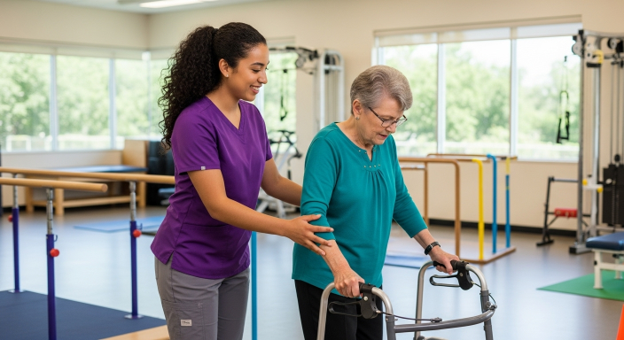Finding the Right Occupational Therapy Schools: What to Consider
Published - October 25, 2025


Table of Contents
The Growing World of Occupational Therapy
Occupational therapy is an exciting and expanding field focused on helping people improve their ability to engage in daily activities, which ultimately boosts their overall quality of life. As this profession grows, picking the right school for occupational therapy becomes an important step for students eager to start their careers. Things like the quality of education, hands-on experience opportunities, and the support systems in place at the school can shape a student’s future. This guide shines a light on the key factors you should think about when exploring various occupational therapy programs.
Why Accreditation Matters and How to Check It
Accreditation is all about making sure that a school or program meets specific quality and educational standards. For those looking into occupational therapy, enrolling in a program accredited by ACOTE (the Accreditation Council for Occupational Therapy Education) is super important. This accreditation ensures that the program meets the educational benchmarks necessary for you to become a competent professional and qualify for national certification exams.
To check if a program is accredited, here’s what you can do:
- Visit the official ACOTE website for a current list of accredited programs.
- Make sure the school aligns with the latest accreditation standards, which will be fully in place by 2025, aimed at boosting the quality of occupational therapy education.
Getting a good grasp on these aspects means you can steer clear of programs that aren’t recognized, helping you choose an educational path that supports your career.
Evaluating Program Quality: What to Look For
A top-notch occupational therapy program has a few key ingredients. Faculty qualifications are at the forefront; it’s wise to choose programs with experienced instructors who bring both academic credentials and practical know-how to the table. Plus, a strong curriculum should blend classroom learning with ample hands-on training, crucial for building the skills you’ll need to shine as an occupational therapist.
To get a better feel for a program’s quality, consider these evaluation criteria:
- Student-to-Faculty Ratios: Smaller ratios typically mean you’ll get more personalized attention and mentoring.
- Clinical Placement Opportunities: Gaining experience in real settings is key in this field, so look for programs that partner with local healthcare facilities for training.
- Feedback from Current and Former Students: Reviews can give you a window into their experiences, revealing both the strengths and areas for improvement in the program.
Also, rankings from reliable sources like U.S. News & World Report can offer valuable insights into a program’s standing in the field, helping you make a wise choice.
Related Question: How can I assess the quality of an occupational therapy program?
When looking into an occupational therapy program, consider the faculty’s qualifications, how rigorous the curriculum is, and the availability of hands-on clinical placements. Analyzing student feedback and outcomes, like graduation and certification exam pass rates, adds even more clarity. Using rankings from trustworthy sources guarantees that you’re aligning your choices with performing institutions in OT education.
Understanding Costs: Tuition and Financial Aid
Figuring out the financial side of attending occupational therapy school is an important step for prospective students. Tuition rates can vary widely depending on the program and whether you’re classified as an in-state or out-of-state student. In California, students pursuing a doctoral-level occupational therapy program can expect total costs that often range from the mid-$50,000s for residents to over $100,000 for non-residents.
To lessen financial stress, students should look into various financial aid options, such as:
- Scholarships: Many programs provide scholarships specifically aimed at students in healthcare to encourage fresh talent in the field.
- Federal Loans: Accessible loans can help cover education expenses, and being clear on the terms can help you create smart repayment strategies.
Diving into research on grants and scholarships can significantly ease the financial load and impact your program choice positively. For more information on financial support, you can refer to our financial aid resources.
Related Question: What costs are associated with attending occupational therapy school?
Aside from tuition, don’t forget about additional costs like textbooks, materials, and clinical fees. These expenses can differ quite a bit between institutions and based on residency status, so it’s essential to keep these in mind for overall affordability. Checking out diverse funding options, especially those catered to occupational therapy, helps you make sound choices that lessen your financial concerns.
Personal Fit: Evaluating Program Culture and Support Services
Choosing the right program goes beyond just academic metrics; making sure it feels like the right fit is so important for a successful experience. A supportive and inclusive environment can really help students thrive. As you explore, look for programs that offer strong support services like:
- Mentorship Opportunities: Getting paired with seasoned professionals can offer guidance and networking that boosts your career readiness.
- Counseling Services: Easy access to mental health resources is vital, especially during intense study times.
- Community Engagement: Programs that encourage you to get involved with the community can enrich your learning and help develop the interpersonal skills crucial for success as an occupational therapist.
Class sizes, resources, and faculty interaction all contribute to a sense of belonging and support. Attending open houses, campus tours, and chatting with current students can provide great insights into what you’ll find there. For information on available student services, check our student services page.
Career Outcomes: Employment Rates and Alumni Success
The job market for occupational therapists looks bright, with employment expected to grow by 14% from 2024 to 2034, which is much faster than the average for other jobs. When looking at OT programs, consider the career support services the institution offers, like job placement help and networking opportunities.
Programs that actively link students with alumni and mentors can boost job readiness once you graduate. Plus, checking out success stories from alumni gives you a glimpse into the career paths available after finishing the program. Schools that track employment statistics and maintain engaging alumni networks often create even richer opportunities for their students. For examples of successful alumni, visit our alumni spotlight section.
Key Takeaways
Selecting an occupational therapy school is a big decision that can shape your career. It’s essential to consider factors like program accreditation, curriculum quality, costs, personal fit, and potential career outcomes. By aligning your choices with these important considerations, you can find a program that fits your unique goals and circumstances. Taking the time to evaluate these elements helps you make informed decisions, setting you up for a fulfilling career as an occupational therapist.
Keep in mind that the world of occupational therapy education will continue to expand, bringing new teaching methods, greater access to clinical experiences, and a stronger focus on teamwork across different professions. Aspiring students should stay adaptable and proactive in finding programs that meet both current standards and prepare them well for the dynamic healthcare landscape ahead.
FAQs
What is the typical duration of an occupational therapy program?
Most occupational therapy programs take about two to three years to complete, depending on whether students are pursuing a master’s or doctoral degree. Knowing how long the journey will be can help you plan accordingly.
Are there online options available for occupational therapy degrees?
Absolutely! Many programs now offer flexible online or hybrid options, allowing students to juggle their studies with personal commitments. This flexibility is particularly helpful for those with work or family obligations.
What prerequisites do I need before applying to an OT program?
Generally, you’ll need a bachelor’s degree, certain coursework in related fields, and some volunteer or work experience in healthcare settings. Completing these steps makes sure you’re ready for your OT education.
How important is hands-on clinical experience in OT education?
Hands-on clinical experience is essential, letting you apply what you’ve learned in the classroom to real-life situations. Engaging in internships and practical experiences builds your skills and confidence, making you better prepared for your role as an occupational therapist.
